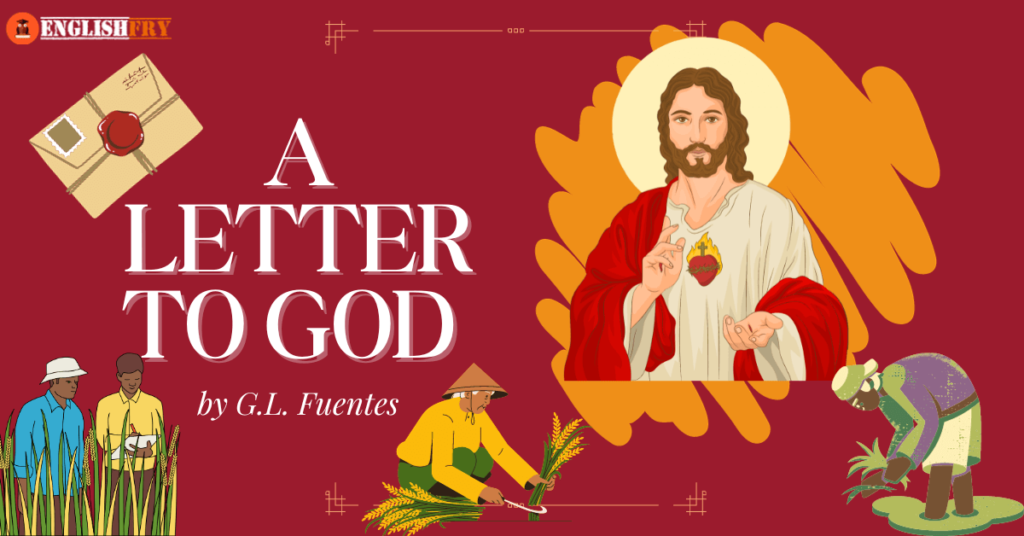“Ballad Breakdown: Poetic Devices & Explanation in In this captivating exploration of Ogden Nash’s “Tale of Custard the Dragon,” we delve into a poetic masterpiece that transcends time. The whimsical narrative introduces us to a magical world filled with courage, friendship, and unexpected twists. Nash’s poetic prowess shines through as he employs various literary devices, from clever wordplay to vivid imagery, creating a carefully crafted work of art.
The article takes a multifaceted approach, offering academic insights for Class 10 students, line-by-line explanations, key points for deeper understanding, and even a section of interactive elements like questions and multiple-choice quizzes. The ballad form adds a unique rhythm, while the summary distills the essence of the tale for quick comprehension. As we conclude, we reflect on the richness of Nash’s creation, acknowledging its potential to transport readers to a world where imagination knows no bounds. Whether you’re a student, poetry enthusiast, or someone seeking a delightful tale, “Tale of Custard the Dragon” has something profound to offer.
Table of Contents
ToggleThe Tale of Custard the Dragon Analysis by Ogden Nash
“The Tale of Custard the Dragon” is said to be Ogden Nash’s most famous poem for children. It was published in 1936 as part of his collection of poetry entitled The Bad Parents’ Garden of Verse. A few years later, a picture book of the poem was published with illustrations by the famous Lynn N. Munsinger. Read The Tale of Custard the Dragon detailed analysis and more here on A tale of custard the dragon questions and answers is given below.
Ogden Nash, renowned for his contributions to children’s poetry, presents “The Tale of Custard the Dragon” as a fairy tale. The narrative structure adheres to the simplicity inherent in traditional fairy tales, yet its underlying moral imparts a significant lesson – the imperative avoidance of premature judgments. Scholars often posit that fairy tales serve as didactic tools, instructing children on navigating the complexities of the world. Comparable to cautionary tales advising against venturing into the forest alone, Nash’s poem introduces fantastical entities such as dragons alongside commonplace characters like cats, dogs, and mice.
In the narrative, the characters, including Belinda and her smaller animal companions, are anthropomorphized. Despite their initial display of courage, when faced with an actual threat, such as the pirate, their valor wanes. Notably, Custard, the ostensibly timid and fearful dragon ridiculed throughout the poem for his desire for a secure enclosure, emerges as the hero. His act of devouring the pirate in a single gulp underscores a transformation from cowardice to bravery. Consequently, Custard defies initial perceptions and reveals his true mettle.
Conversely, the pirate, initially portrayed as bold and fearless, crumbles in the face of Custard’s charge. This juxtaposition underscores the theme that both Custard and the pirate defy superficial judgments. Nash’s didactic purpose becomes apparent – urging readers not to hastily assess individuals based on appearances. The narrative illustrates that, inevitably, the genuine nature of a person will manifest, whether it aligns with virtue or vice. Nash strategically employs the fanciful elements of the tale as a vehicle to impart this timeless moral lesson.
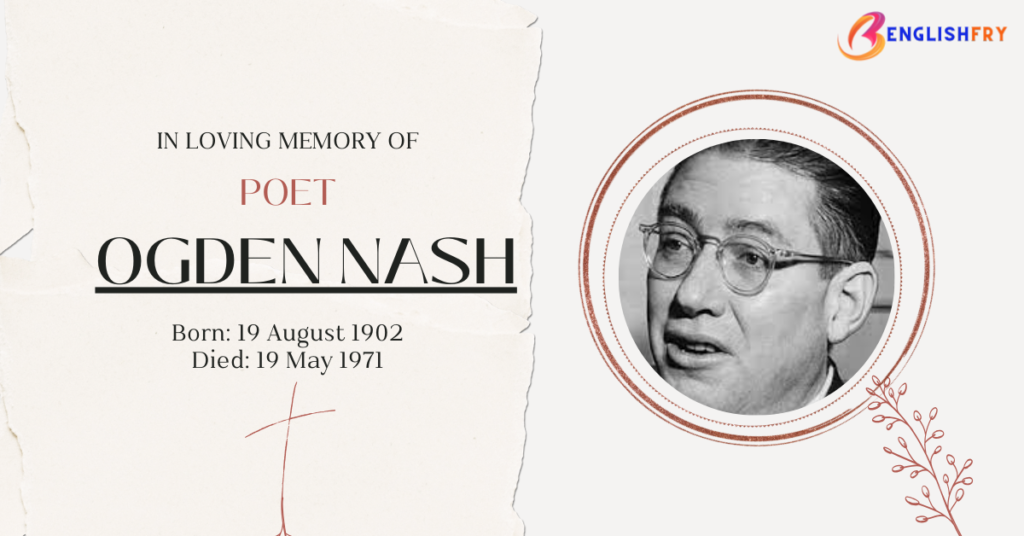
The Tale of Custard the Dragon line by line explanation
1st stanza:
Belinda lived in a little white house,
With a little black kitten and a little grey mouse,
And a little yellow dog and a little red wagon,
And a realio, trulio, little pet dragon.
In this stanza, a little girl Belinda lives with her pets in a white house. These pets are a black kitten, a grey mouse, a yellow dog and a dragon.They all use a red wagon when they want to go out somewhere.
2nd stanza:
Now the name of the little black kitten was Ink,
And the little grey mouse, she called her Blink,
And the little yellow dog was sharp as Mustard,
But the dragon was a coward, and she called him Custard.
In this stanza, The name of the kitten is Ink because the colour of the kitten is black like ink,the name of the mouse is Blink because the mouse is tiny ( very small ), the name of the dog is Mustard because the dog colour is yellow like mustard, and the name of the dragon is Custard because the dragon is coward and sweet like custard
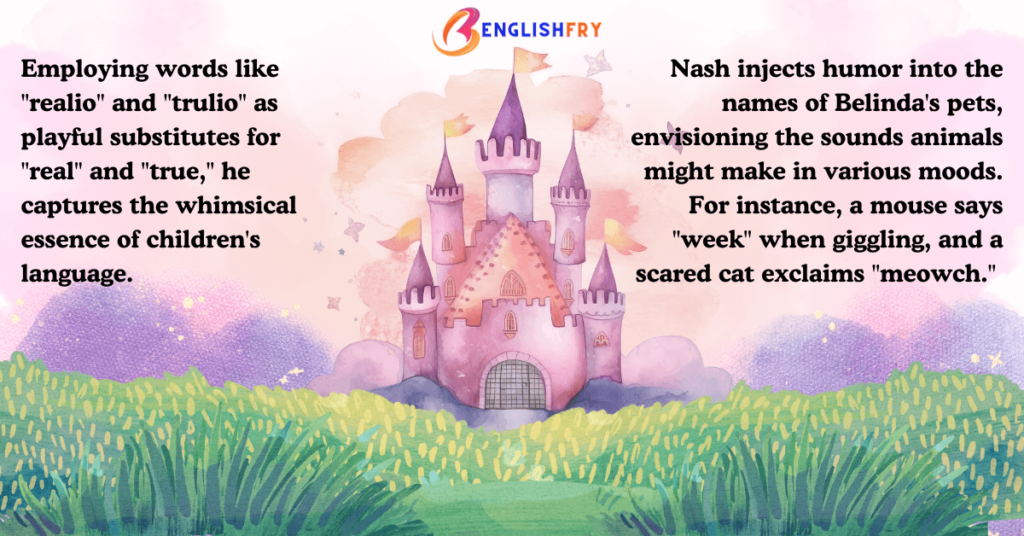
3rd stanza:
Custard the dragon had big sharp teeth,
And spikes on top of him and scales underneath,
Mouth like a fireplace, chimney for a nose, And
realio, trulio, daggers on his toes.
In this stanza, we see that Custard is a big dragon.Custard has big sharp teeth, spikes on his back, scales on his stomach and dagger-like toes.Custard can also give out fire from his mouth.
4th stanza:
Belinda was as brave as a barrel full of bears,
And Ink and Blink chased lions down the stairs,
Mustard was as brave as a tiger in a rage,
But Custard cried for a nice safe cage.
In this stanza, we are told that Belinda, Ink, Blink and Mustard were all brave, even thoughthey were much smaller in size than Custard, but Custard was socowardly that he alwayswanted to hide in cage to be safe.
5th stanza:
Belinda tickled him, she tickled him unmerciful,
Ink, Blink and Mustard, they rudely called him
Percival, They all sat laughing in the little red
wagon At the realio, trulio, cowardly dragon.
In this stanza, Belinda and all the pets made fun of coward Custard. Belinda tickled him. Blink and Mustard mocked Custard and called him the brave knight Percival (Blink and Mustard ironically compared Custard with the brave knight called Percival, who had been in the service of King Arthur to show him how unlike Percival he really was)
6th stanza:
Belinda giggled till she shook the house,
And Blink said Week!, which is giggling for a mouse,
Ink and Mustard rudely asked his age,
When Custard cried for a nice safe cage.
In this stanza, when Custard wanted to be put in a cage because of fear, Belinda and Blink laughed so much at him. Ink and Mustard asked him his age because like a child he was scared of every little thing.
7th stanza:
Suddenly, suddenly they heard a nasty sound,
And Mustard growled, and they all looked
around. Meowch! cried Ink, and Ooh! cried
Belinda, For there was a pirate, climbing in the
winda.
In this stanza, suddenly, Belinda and her pets heard an unpleasant sound and were scared .Mustard started growling. Ink and Belinda cried out in fear, and finally they saw that a pirate was climbing into their house through a window.
8th stanza:
Pistol in his left hand, pistol in his right,
And he held in his teeth a cutlass bright,
His beard was black, one leg was wood;
It was clear that the pirate meant no
good.
In this stanza, we see that the pirate had one pistol in left hand and one pistol in his right handand a cutlass, (a small sword ) between his teeth. He also had a beard and a wooden leg. It was clear that the pirate was dangerous.
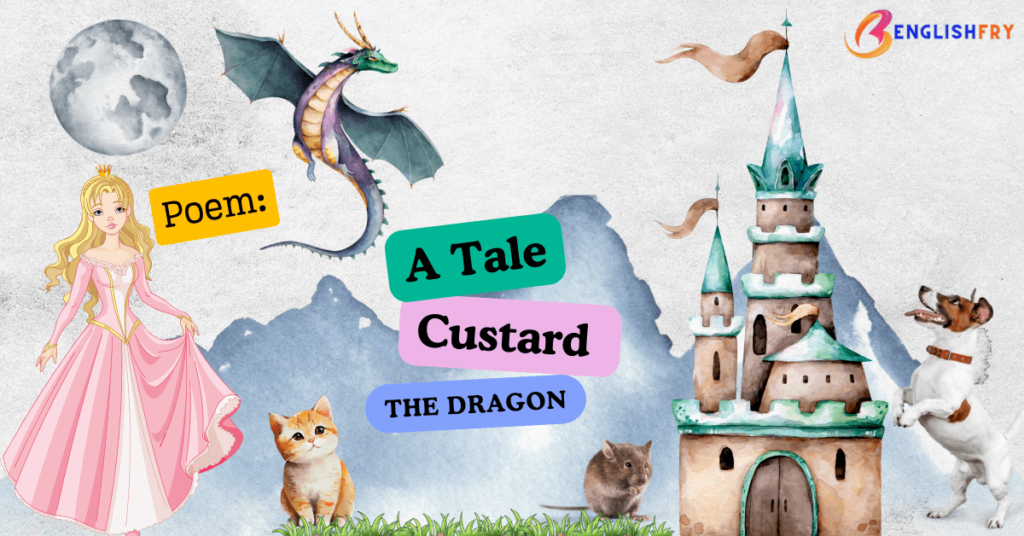
9th stanza:
Belinda paled, and she cried, Help! Help!
But Mustard fled with a terrified yelp,
Ink trickled down to the bottom of the household, And
little mouse Blink strategically mouseholed.
In this stanza, we see that Belinda became pale with fear. She started to cry for help, Mustard ran away in fear, Ink hid in the basement, and Blink went into his mouse hole.
10th stanza:
But up jumped Custard, snorting like an engine,
Clashed his tail like irons in a dungeon,
With a clatter and a clank and a jangling squirm
He went at the pirate like a robin at a worm.
In this stanza, we are told that Custard surprised everyone with his actions. He jumped up and started snorting in anger like an engine. Then Custard beat his tail against the floor, and that made the sound like the metal chains in a dungeon being clashed against one another. Finally, he ran towards the pirate and attacked him in the same way that a robin bird pounces on a worm.
11th stanza:
The pirate gaped at Belinda’s dragon,
And gulped some grog from his pocket flagon,
He fired two bullets but they didn’t hit, And
Custard gobbled him, every bit.
In this stanza, the pirate reacted to Custard. He stared at Custard, the dragon, helplessly and drank alcohol from his flagon. He fired two bullets at Custard with his pistol but missed. Finally, Custard ate him up in one bite.
12th stanza:
Belinda embraced him, Mustard licked him,
No one mourned for his pirate victim
Ink and Blink in glee did gyrate Around
the dragon that ate the pyrate.
In this stanza, Belinda hugs Custard and Mustard licked him. So both Belinda and Mustard appreciated Custard. Nobody was sad for the pirate who had been eaten. Instead, Ink and Blink started dancing in a happy mood around Custard.
13th stanza:
Belinda still lives in her little white house,
With her little black kitten and her little grey mouse,
And her little yellow dog and her little red wagon,
And her realio, trulio, little pet dragon.
In this stanza, we are told that everything has gone back to normal again. Belinda is living once again in peace with her pets in her white house.
14th stanza:
Belinda is as brave as a barrel full of bears,
And Ink and Blink chase lions down the
stairs, Mustard is as brave as a tiger in a rage,
But Custard keeps crying for a nice safe cage.
In this stanza, we are told that Belinda, Ink, Blink and Mustard are still brave despite knowing that the pirate could have easily killed them all. On the other hand, Custard is still a coward and still longs for a safe cage.
Poetic Devices in The Tale of Custard the Dragon :
Each of the 14 stanzas in “The Tale of Custard the Dragon” follows the same simple rhyme scheme – AABB. That is to say, each stanza is actually composed of a pair of rhymed couplets.
Rhetorical devices:
Oxymoron: In this rhetorical device, contradictory terms appear in conjunction. In this poem, the poet uses the device of oxymoron when he writes the phrase “pet dragon”. We all know that dragons are dangerous creatures, and therefore, we find it hard to believe that they can be domesticated and kept as pets.
Simile: This rhetorical device is used when an overt comparison is made between two different things. In this poem, the poet uses the device of simile in the 3rd line of the 2nd stanza when he compares Belinda’s dog with mustard, saying that both are sharp, and also uses the word “as” while making the comparison. The poet also uses this device in the 3rd line of the 3rd stanza when he compares the dragon’s mouth with a fireplace, and also uses the word “like” while making this comparison. In the 4th stanza, similarly, the poet compares Belinda with a barrel of bears, and her dog with a tiger. In the 10th stanza, the dragon is compares with an engine and a robin, and the sound of its tail with that of irons in a dungeon.
Metaphor: This rhetorical device is used when a covert comparison is made between two different things or ideas. In this poem, the poet uses the device of metaphor in the 3rd line of the 3rd stanza when he compares the dragon’s nose with a chimney.
Personification: This rhetorical device is used to bestow human qualities on something that is not human. In this poem, the poet uses the device of personification with respect to Belinda’s kitten, mouse, and dog. In the 2nd line of the 5th stanza, he gives them all the human ability to speak to and tease another being. They are seen teasing the dragon.
Onomatopoeia: This rhetorical device is used when a word is used to describe a sound. In this poem, the poet uses the device of onomatopoeia in the 2nd line of the 6th stanza, where he uses the word “week” to describe the sound a mouse makes while giggling.
Compound Words: Compound words are formed by adding two words into a single one, when normally those words are not used together. In this poem, the poet uses the device of compound word in the 3rd line of the 7tth stanza when he combines the words “meow” and “ouch” to create the word “meowch”.
Transferred epithet: This rhetorical device is used when an emotion is attributed to a non-living thing after being displaced from a person, most often the poet himself or herself. In this poem, the poet uses the device of transferred epithet in the 2nd line of the 9th stanza when he writes the phrase “terrified yelp”. It is not the yelping sound that is terrified, for it is not a living thing, but that the dog is terrified by the pirate and yelps in reaction.
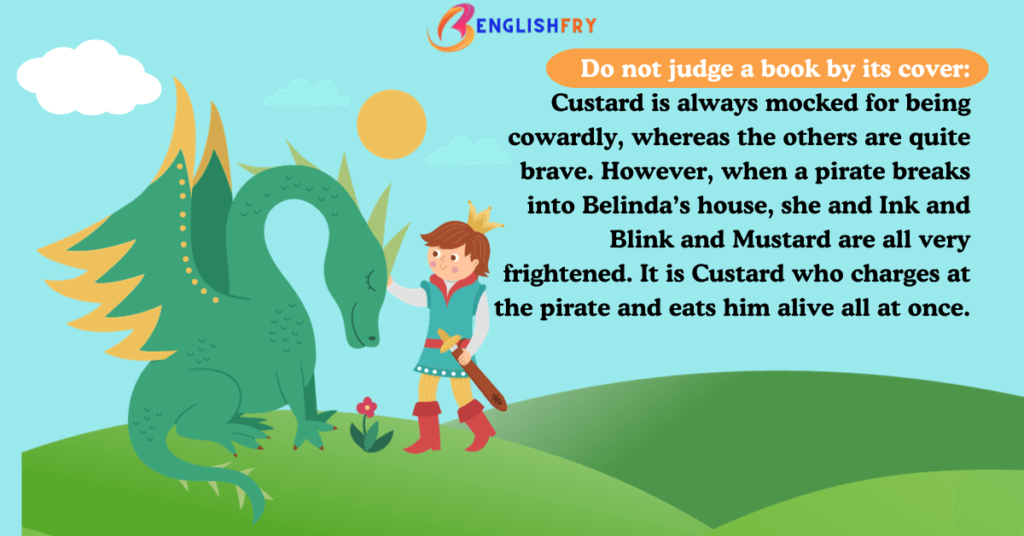
Themes of The Tale of Custard the Dragon :
In “The Tale of Custard the Dragon,” Ogden Nash intricately weaves a narrative emphasizing the age-old adage: “Do not judge a book by its cover.” Despite Custard being perennially mocked for his perceived cowardice, the narrative takes an unexpected turn when a pirate intrusion evokes fear in Belinda, Ink, Blink, and Mustard – all ostensibly brave characters. Custard, the one previously dismissed as the most timid, emerges as the unexpected savior, fearlessly confronting the pirate and consuming him in one swift act. The juxtaposition between Custard’s initial portrayal and his decisive action challenges preconceived notions, illustrating the inherent complexity of character.
Conversely, the pirate, initially exuding bravado upon entering Belinda’s abode, undergoes a drastic transformation upon encountering Custard’s fearless charge. Stripped of his bluster, the pirate, faced with his inevitable fate of being consumed, resorts to staring at Custard and seeking solace in a drink. This striking reversal of roles between Custard and the pirate serves as a poignant reminder that individuals often defy their initial appearances, urging restraint in premature judgments.
Nash employs a deliberately child-friendly vocabulary to engage his primary audience effectively. Employing words like “realio” and “trulio” as playful substitutes for “real” and “true,” he captures the whimsical essence of children’s language. Additionally, Nash injects humor into the names of Belinda’s pets, envisioning the sounds animals might make in various moods. For instance, a mouse says “week” when giggling, and a scared cat exclaims “meowch.” Nash’s poetic exploration extends to attributing dance to animals in moments of happiness. These linguistic and imaginative choices contribute to the poem’s appeal to children, making Nash’s work a delightful and instructive experience for his young readers.
Tone of The Tale of Custard the Dragon :
The tone of this poem is humorous for the most part. A tone of suspense comes in when the pirate enters Belinda’s house, but that is soon replaced by joy when Custard saves the day. It could be argued that the thought of a man being eaten alive is quite scary and inappropriate for children, but the way in which Nash tells us the story is bound to make us laugh.
Conclusion:
“The Tale of Custard the Dragon” is one of the best-loved children’s poems by Ogden Nash. It story is delightful, its vocabulary humorous and its characters loveable. Its message is also one that children are likely to remember and apply in real life. Hence we can easily say that Nash has been successful in his purpose of writing this fanciful tale. Read more: The Tale of Custard the Dragon Summary by Ogden Nash

Very Short Answer Questions
1)Where did Belinda live?
Ans: Belinda lived in a little white house.
2)What was the colour of the kitten?
Ans:Black
3)Apart from the kitten which other animals were living with her?
Ans:Mouse, dog and a dragon
4)How is Belinda described in the stanza?
Ans:Belinda is as brave as a barrel full of bears.
5)How did Ink and Blink show their strength?
Ans:Ink and Blink chase the lions down the stairs.
6)How did Mustard show his bravery?
Ans:Mustard is as brave as a tiger in a rage.
7)What did Custard cry for?
Ans:Custard keeps crying for a nice safe cage.
The Tale of Custard the Dragon Question and Answers
1.Why did Belinda cry for help ? Who came to her help?
Answer : Malinga cried for help because she was afraid of the pirate. Custard came to her help
2.How did Belinda’s pets other than custard face the pirate? Answer : All the animals other than the Dragon used to boost about their bravery and make the fun of the Dragon but when the pirate entered the house all got scared,ran and disappeared except custard the Dragon.
3.How did each of Belinda’s pets react at the site of the pirate?
Answer : Each of Belinda’s pets ran away and hid. They were scared at the sight(view) of the pirate
4.Give a brief description of the pirate in the poem “The Tale of custard the Dragon’.
Answer : The pirate entered from the window .He had pistols in his left and right hand. He held a bright cutless in his teeth .His beard was black and one leg was wood.
5. Who all lived in a White Housewith Belinda?
Answer : Belinda lived in a white house with Ink a black kitten Blink a grey Mouse ,Mustard a yellow dog ,Custard the Dragon and a red wagon.
6.Why did everyone make fun of the Dragon?
Answer : Everyone in the house used to laugh at the Dragon because he always cried for a safe cage. The dragon looked fearful but his nature was mild .
7.How did they say/express there admiration for the Dragon after the death of the pirate?How did Belinda and the other pet animals appreciate the bravery of custard?
Answer : They became very happy when custard killed the pirate. Belinda embraced(hug) him, Mustard licked him,Ink and Blink jumped round surrounding him to expresse joy . No one mourned (felt sad) for the pirate.
8.What did they say about their bravery after the pirates death?
Answer : Mustard said that he would have been twice as brave if he had not got nervous .Think and Blink also said that they would have been three times as brave as custard.
Custard instead agreed to whatever they said .Infact custard accepted that they were braver then him.
9.What is a ballad ?How is the Tale of custard the Dragon a Ballad?
or
Why is the poem “The tale of Custard the dragon” called a ballad?
Answer : Ballad is a poem that tells the story .The theme of a ballad is adventure, bravery, Romance etc. It is highly musical due to its rhyme scheme. This poem has all these qualities but it is a parody of a Ballad. The poet shows these qualities in a humorous way. The poem “The tale of Custard the dragon” is called a ballad because it narrates the tale of courage or heroism of the cowardly dragon.
10.How did the animals make fun of the Dragon?
Answer : Belinda teased the Dragon . She tickled him very hard . Ink, Blink and Mustard called him percival. They set in the red wagon and laughed at the cowardly Dragon.
11. How did Belinda and the other animals behave after observing the pirate?
Answer : Belinda turned pale with fear. She cried for help Mustard ran barking fearfully. Ink went to the bottom of the house .The little mouse ran into his hole in no time.
12. How did custard proof to be brave when the pirate came ?
Answer : Custard the Dragon jumped and snorted like an engine. He struck the pirate with his tail like Iron .There were different sounds of clatter clank and jangle. He attacked the pilot as a robin attacks a worm.
13. How did the pirate react when the Dragon attack him?
Answer : The pirate looked at the Dragon with an open mouth He swallowed some liquor from his pocket flagon. He fired two bullets but that did not hit the Dragon at last the Dragon attacked him and swallowed him completely.
14. Where did Belinda live ? Which animals lived with her ?
Answer : Belinda lived in a Little White House . Some animals also lived with her .They were a little black kitten, a little grey mouse, a little yellow dog named mustered and a Dragon named custard .
15.Describe the fight between the Dragon and the pirate .
Answer : The Dragon had big sharp teeth ,spikes on top of him and scales underneath but everyone laughed at him because he always cried for a safe cage.
On the other hand the animals and Belinda boosted about their bravery .When the pirate entered all were scared and ran away except custard who faced him boldly.
Custard the Dragon jumped and snorted it like an engine. He struct the pirate with his still like Iron tail. There were different sounds of clatter ,clank and jamgle. He attacked the Pilot as a Robin attacks a worm .All of them later felt obliged to custard for saving their lives at the right moment .
16. Why did Ink and Blink gyrate(dancing in circular motion) and glee (joy) ?
Ans : Ink and Blink gyrated in glee because the piratehad been entered attacked and gobbled by Custard the dragon.
17. What is the rhyme scheme of the poem ?
Ans : The rhyme scheme of the poem is aabb.
18. Evaluate Ogden Nash’s ‘The Tale of Custard the Dragon’ as a ballad. What message does the poet give to the readers in this poem?
Ans. Ballads are stories told in verse. Generally, ballads are tales of adventures and heroism. In the poem, the poet does present the encounter of Custard and the pirate in the typical spirit of a ballad. The four-line stanzas have the rhyme scheme: aa,bb throughout the poem. Ogden Nash gives a subtle message to the readers through the fate of Custard, the dragon. In this world
of deceit, self-confidence, self-dependence and self-respect are essentials to earn your rightful place among your peers. The mere presence of physical strength is not enough. The more important point is that you must be conscious of your strength. You must be fully aware of the fact that many others who are far inferior in strength and power should have no right to taunt and ridicule you.
19. In spite of being so powerful and displaying rare bravery of killing and swallowing the pirate, why does the dragon Custard taunt as being a coward always asking for a nice safe cage?
Ans. No doubt, Custard has a lot of physical strength. Even his exterior was quite formidable. He had big sharp teeth. There were spikes on his top. There were scales underneath. His mouth was like a fireplace always spitting fire. He proved his strength and bravery when he encountered the terrible pirate. The pirate had two pistols and a dagger but failed to hurt or overpower Custard. The dragon fought valiantly and swallowed the dragon within no time. Custard is constantly ridiculed and taunted by the weaker and more cowardly pets of Belinda. The reason was simple. Custard had no self-respect. Nor was he aware of his great strength. He had a very low opinion of himself. He always asked for a nice safe cage for his protection. This was the reason that he was always taunted and ridiculed as a coward.
Founder of Englishfry.com, a captivating and knowledge-driven blog & Founder of Android app/website Studyfunnel.com, an online Mock Test Series Portal. With a wealth of experience spanning over 16+ years, he has excelled as an Ex-professor, Teacher, Amazon published author, Website Developer, Graphic Designer,Blogger,Poet, and Creative academic content writer publisher of 4 academic books. His tryst in Literature helped him realize his love for writing and telling stories. A tech-savvy language nerd by day and, a passionate writer by night, he now translates his experiences into tales of wisdom served with a side of humor.His widely recognized profound insights ,captivating writing style of weaving words make him contribute to prestigious publications and a sought-after authority in the field that transport readers to extraordinary worlds.




